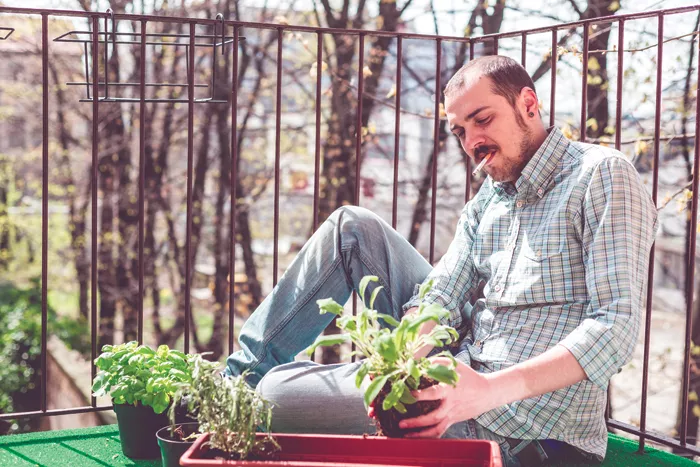I used to garden as if I had something to prove, as if my garden was a measure my worth. I had clear production goals, and took it as my duty to put food not only on the table, but in the freezer for a winter. Those days are over. Now my garden is like a cross between a yard ornament and the lab of a mad scientist, as much a half-baked expression of my artistic vision as a reflection of the gardener, the way pets come to resemble their owners. But I’m at peace with my hobby garden, as my expectations are in line with what it can provide.
I still want to harvest the maximum amount of produce that my modest efforts and limited space will allow, but just as much, I want to enjoy the garden. It has a lot to offer beyond pounds of food, perhaps none greater than the satisfaction of using the garden as a tool with which to interact with the forces of nature. It’s like the connection an angler feels with a fish on the line. But gardening adds the element of creation.
The gardens I’ve been creating in recent years are dense and very diverse, like edible toy ecosystems. The practice of growing lots of plants in the same spot, often called polyculture, has yielded a different looking garden each summer. But they’ve all been interesting, fun, and productive. Here are the general laws by which I abide in the creation of my edible ecosystems:
Law #1: Bare dirt is the enemy
A photon that hits the ground is a wasted photon. What’s more, it’s a wasted photon hitting wasted ground, where something could be growing. In spring and early summer, bare dirt is inevitable while the garden fills in. But in a mature garden, every photon that falls within your garden should hit something green, not brown. Covering the bare soil prevents it from drying out and blowing away, while allowing it to hold onto its valuable moisture.
I plant primarily by seed, aiming for a ground-covering blanket. I fill bald spots with starts from the farmers market.
Law #2: Minimize Labor
If you follow the first law, much of the garden work will take care of itself. By filling every inch of garden space, especially on the soil surface, you aren’t leaving any room for potential weeds to grow. This leaves more time for sipping iced tea.
Another labor-saving technique I use that’s specifically adapted to polyculture gardens is one I call “Throwing Seeds at Garden” (pronounced with a cadence normally reserved for Tai Chi moves). Simply mix the seeds together for what you want to grow, and toss handfuls of it at your prepared dirt. The mix could be a blend of leafy green seeds that you toss between your rows of corn and peas, or it could be a diverse assortment that you broadcast just to see what happens. This technique has helped me find, among many other discoveries, the place in my garden where parsley grows best.
When mixing and matching plants in your garden, it helps to know how the various players might get along. Members of the cabbage family, for example, such as broccoli and kale, do poorly when crowded with a bunch of other random plants. Onions and garlic are notoriously bad companions to beans, and don’t do well in partial shade.
After throwing your seeds, rake them in and sprinkle shovelfuls of compost over them. In order to keep your garden a garden, and not a bird feeder, cover the bed with shade cloth or floating row cover, available at most gardening stores, until the seeds sprout. Keep the bed well-watered.
This isn’t the most efficient way of sowing one’s seeds. Some will grow too close together and get shaded out, or be pulled by the gardener to make room for some other sprout. If you’re going to toss seeds at your garden, you have to be comfortable yanking redundant or poorly placed seedlings. That’s how you make room for the tomato and pepper starts.
Remember, this haphazard planting style should only be tried in smaller plots. Harvesting from a large garden that was planted by throwing would be a nightmare. But in a small-scale garden on which realistic expectations are placed, tossing some seeds is a fun way to get the action started.
Law #3: Garden in Three Dimensions
A garden doesn’t just exist on the surface of the earth. It can operate above and below ground as well. Understanding this can effectively increase the amount of land you have to work with, by roughly a factor of three. Gardening in 3-D all but ensures that the ground will be covered, and will enhance your harvest of other intangibles by making your garden more diverse, colorful, interesting, and fun.
Corn is a crop that’s particularly well-suited for taking advantage of the airspace above your garden. Planting peas, or some other climbing plant, at the base of the corn plants allows them to crawl up the stalks. You won’t have to set up a trellis, much less find a spot in the garden for a dedicated pea patch, because the corn stalks are essentially free real estate. Peas, being legumes, have roots that convert nitrogen from the atmosphere into a form useable by plants, which helps the entire garden.
With corn and peas towering above the garden floor, there are still ground-level and below-ground spaces to fill. A mix of spinach and carrots would do the trick. Both are shade tolerant, ground-covering plants.
Altogether, the plants share not just space, but interlocking ecological niches as well. The individual players are interchangeable, as long as specific needs of the game are filled. Spinach could be replaced by squash, melons, lettuce, or endive. Beets or radishes could substitute for carrots; sunflowers for corn stalks. Or you could do like me and grow corn, sunflowers, beans, peas, spinach, lettuce, squash, melons, and cucumbers, all in the same spot.
Then, brew some iced tea, and enjoy the drama of your toy ecosystem as it unfolds.






